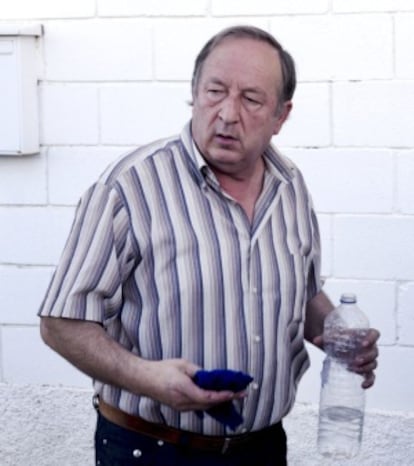Suspect arrested in stolen heritage case
Investigators uncover more than 2,000 ancient artifacts in ongoing probe

In a corner of an industrial estate in Utebo, Zaragoza, an unassuming 63-year-old washes his car with a bottle of water. Apparently calm, Mariano Ostalé Martínez has not changed his usual habits. He still works each day in his woodworking shop in Zaragoza and hasn't been on holiday.
But on at least one occasion during the summer he has spent the day elsewhere; on August 4 he was arrested by the Civil Guard and provisionally charged with crimes against National Heritage. More than 2,000 valuable archeological artifacts were uncovered at two properties belonging to Ostalé, as well as maps of ancient settlements marked with a suspicious-looking X.
"I'm an atypical person, because I study for my country. My entire life has been devoted to analyzing Celtiberian cities: but only in books, not in the field," he says. An expert on the subject, he is in demand at symposiums and has written books. But, he stresses, he has never been on a dig.
However, the Civil Guard believes that Ostalé has in fact been pillaging ancient sites for years. The local mayor of Alagón, where Ostalé has a house, says his neighbor used to go to excavate, but adds that he does not know to what end. He also denied knowing that Ostalé had been detained, despite living in the same street, which was cordoned off by the Civil Guard on the day he was detained.
Ostalé kept maps of ancient settlements marked with a suspicious-looking X
When his property was searched, the police found arrow heads, swords, coins and other metal objects in cupboards and boxes in a far from museum-grade state. "They almost fell apart." Now, archeologists are studying and preserving the pieces.
Ostalé's son, César, laughs off the accusations: "Maybe the helmet that has been in the news was mine," he jokes outside the house in Alagón. César says his father is merely a collector who buys or recreates pieces from the Celtiberian era. He describes any other notion as "surreal." However, the helmet recovered from Ostalé is probably worth a lot more than a child's toy: "It looks similar to the Celtiberian pieces auctioned in Munich," say the Civil Guard.
The pieces in question are 18 bronze helmets dating from the fourth to second centuries BC that were taken from the Celtiberian settlement at Aratikos, near the modern-day town of Aranda de Moncayo in Aragon. The extremely valuable helmets then turned up in Germany in the 1990s, which proved to be the jump-off point for the current investigation.
The Römisch-Germanisches Zentralmuseum (RGZM) in Mainz, one of the most important centers of archeological investigation in the world, alerted the authorities that the pieces were circulating on the collectors' market.
It looks similar to the Celtiberian pieces auctioned in Munich"
They were eventually acquired by the late Austrian industrial tycoon Alex Guttman, who amassed an enormous collection of warrior artifacts during his lifetime. Following Guttman's death, his children placed the helmets under the hammer at auction houses in Munich, Berlin and London. On several occasions archeologists and the German authorities invited Spain to intervene and prevent their sale, but Madrid consistently declined to get involved.
The helmets were sold to private collectors between 2008 and 2012 for prices of between 19,000 and 77,000 euros. Finally, in 2011 and at the request of German prosecutors, the Spanish authorities began to look into the matter.
In March of this year, Operation Helmet I led investigators to the door of Ricardo Granada, a retiree living in Aranda de Moncayo, who had for some 15 years apparently been pilfering from archeological sites in the area using metal detectors. Over the years, Granada amassed more than 4,000 pieces.
Documents and material uncovered during a search of Granada's property led to a second phase of the investigation, dubbed Helmet II, which led to the arrest two weeks ago of Ostalé.
Furthermore, the Civil Guard believes Granada and Ostalé are acquainted and may have carried out excavations together. Investigators have also not ruled out the possibility that Granada acquired the metal detectors he employed from Ostalé's business in Zaragoza.
Ostalé prefers not to elaborate on the case, on the advice of his lawyer. But he denies knowing Ricardo Granada and that he has ever profited from the sale of archeological artifacts. What is certain is that the Civil Guard searched his house in 2001; Ostalé joked around with the officers, and says they were sympathetic toward him. It remains to be seen whether a judge will also see the funny side.
Tu suscripción se está usando en otro dispositivo
¿Quieres añadir otro usuario a tu suscripción?
Si continúas leyendo en este dispositivo, no se podrá leer en el otro.
FlechaTu suscripción se está usando en otro dispositivo y solo puedes acceder a EL PAÍS desde un dispositivo a la vez.
Si quieres compartir tu cuenta, cambia tu suscripción a la modalidad Premium, así podrás añadir otro usuario. Cada uno accederá con su propia cuenta de email, lo que os permitirá personalizar vuestra experiencia en EL PAÍS.
¿Tienes una suscripción de empresa? Accede aquí para contratar más cuentas.
En el caso de no saber quién está usando tu cuenta, te recomendamos cambiar tu contraseña aquí.
Si decides continuar compartiendo tu cuenta, este mensaje se mostrará en tu dispositivo y en el de la otra persona que está usando tu cuenta de forma indefinida, afectando a tu experiencia de lectura. Puedes consultar aquí los términos y condiciones de la suscripción digital.
Últimas noticias
From Hungary’s Orbán to Chile’s Kast: How Trump helps turbo charge the far right
Magnets in their heads: How some animals guide themselves using the Earth’s magnetic field
From Andorra to Gibraltar, a black market for Ozempic exploits its success: ‘They’re the most sought-after products in the world’
From safe-haven investment to geostrategic weapon: Who owns the most gold and where are the bars kept?
Most viewed
- Why we lost the habit of sleeping in two segments and how that changed our sense of time
- Trump’s obsession with putting his name on everything is unprecedented in the United States
- Charles Dubouloz, mountaineering star, retires at 36 with a farewell tour inspired by Walter Bonatti
- Venezuela faces its most tense Christmas yet
- CBS in crisis after pulling a report on Trump’s deportations to El Salvador (which later leaked online)









































